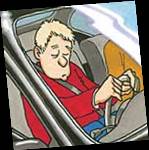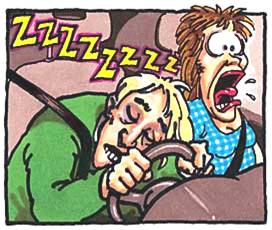Chapter 10: DRIVER FATIGUE
THE SILENT KILLER
Falling asleep at the wheel happens all to often on motor-ways, with terrifying consequences and even if you don't go so far as to actually fall asleep, driving when you are tired means that your concentration and risk perception are impaired, so you're more likely to have an accident.
One of the most common causes of fatigue is lack of stimulation. On a motorway or a road that you travel every day it can be monotonous. Fog, rain and darkness make matters worse because there's even less to see. Because you're not getting any visual or physical stimulation, your senses become dulled, your levels of awareness and alertness decrease. And the longer you drive, the worse it gets.
A driver who is tired before getting into the car (after a hard day's work or a sleepless night) is particularly at risk.
Be careful if you have to drive at times when you would normally be asleep – more fatigue – related accidents occur between midnight and 8 am than at any other time.
Try to reduce the risk of fatigue by taking precautions:
A light meal like a salad, is best when you're about to set out on a long journey. A heavy meal will make you sluggish and tired, whether it's a roast lunch or a three-course evening meal.
Don't take any medications that may induce drowsiness, Remember that drugs and alcohol can stay in your system for a long time.
Driving at night is difficult enough, but if you are suffering from any sight defect or disorder it can be very stressful and tiring.
Have your eyes tested and wear glasses or contact lenses if prescribed. If you know you have a long overnight journey ahead of you, try to sleep during the day.
Prepare the car and do all the necessary packing and route planning, then rest.
Avoid last minute rushing around at all costs.
Rattles and squeaks can be irritating, so do what you can to reduce noise in the vehicle.
Make sure any luggage in the back is packed securely and that you don't have items rattling round on the floor of the car.
Make yourself comfortable, bad posture causes aches and pains, which lead to fatigue setting in. It's particularly important when driving a hire car or a vehicle you're not familiar with to take time adjusting the seat and steering before you set off.
Wear comfortable clothing that doesn't restrict body movement or steering, layers of light, loose-fitting garments are best, that way you can stop and add or subtract layer to achieve the right temperature.
Wear lightweight, flat shoes with enclosed or covered heels, and make sure that the soles grip the pedals. Nothing is worse than shoes which slip off the pedals when you're trying to control the car (Check that the pedal rubbers themselves are not worn and slippery).
Keep a window slightly ajar so that fresh air can circulate.
When planning your route for a long journey, pick out a few places where you can take a break en route, Aim to stop at least every three hours for a 20 minute break. If weather conditions are poor, you may need to stop more frequently.
Mature drivers need more frequent and longer breaks to relieve fatigue.
If you start to feel drowsy at the wheel. Or if you're driving at night and lights start to blur, it's time to take a break.
Pull into a lay by or service area as soon as you can.
Don't stare fixedly at one point. Look as far ahead as possible then check the mirrors left and right, then look ahead again. By focusing on objects close at hand and then in the distance, you will work the optic muscles and help to keep you alert.
When your tired you will be tempted to continue, especially if you have set yourself unreasonable distances and have a long way to go.
Remedies that might provide a short-term fix but in reality will probably lead to a crash are:
- Opening the window and take deep breaths of fresh air.
- If you have a passenger, get them to have a conversation with you.
- If you are alone, turn on the radio and sing along, or try giving a running commentary as you drive.
- Flexing your fingers and toes and stretch each arm and leg in turn while sitting at the controls.
When you are able to stop the car, get out and stretch your legs, go for a walk if it's safe to do so. If not, do a few gentle exercises in the car; Try rolling your head gently, first one way and then the other.
Make circular movements with your shoulders to release some of the tension in our neck and spine. Pour yourself a refreshing non-alcoholic drink before you set off again, as dehydration can make you feel lethargic on long journeys.
HOW FATIGUE AFFECTS THE BODY
The effects of fatigue in relation to driving task are mostly similar to the effects of alcohol for a driver, for example:
- Hot, dry or tired eyes are often the first symptom.
- Judgment of depth and distance is reduced.
- Peripheral (side) vision is greatly reduced.
- Concentration and attention will be affected.
Key points to minimize the onset of fatigue:
Plan to drive only at times you would normally be awake.
- Take regular rest and exercise breaks, usually at least every two hours, more frequently at night.
- Avoid driving with alcohol or other drugs or medication in your system.
- Do not rely on caffeine or other stimulants as they “may” keep you awake but cannot improve your ability to manage concentration or vision.
- Avoid large heavy oily meals. Have small snacks of high-energy food, fruit, and mueslie bars.
- Keep your eyes moving and “wiggle” your toes to improve blood circulation.
- Air conditioning will dry your eyes. Use fresh air.
- Try to share the driving with partner or friend.
- If you start to feel tired, then STOP before it becomes a problem.
DID YOU KNOW?
According to Australian research findings; lack of sleep can cause the same physical and mental impairments as being drunk. Reaction times, accuracy, coordination and attention spans in people who stay awake for up to 19 hours are as bad, or worse than those of drinkers with a blood alcohol concentration level of 0.05 percent. (Dr. Andrew Williamson)
(Written by Joel Neilsen, Managing Director, Safe Drive Training)



